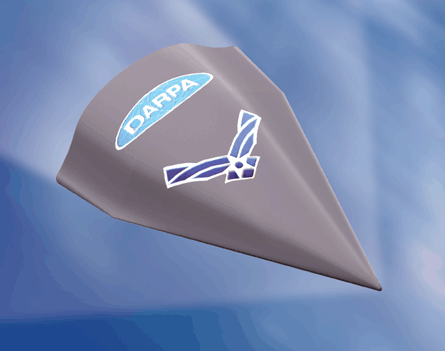The US Defence Advanced Research Projects Agency may have lost contact with its Falcon Hypersonic Technology Vehicle 2 some 9min after launch, but the 23 April mission would appear to stand as a relative success. The Orbital Sciences' Minotaur IV lite launcher executed first of its kind energy management manoeuvres, clamshell payload fairing release and HTV-2 deployment just outside the atmosphere. And, according to DARPA, a preliminary review of data indicates the HTV-2 achieved controlled flight within the atmosphere at over Mach 20.
The plan was for the Lockheed Martin-designed HTV-2 - a dart-shaped glider - to glide across the Pacific Ocean at "13,000 miles per hour" (20,930km/h) for less than 30min, says DARPA, then to hit the ocean north of the Reagan Test Site in Kwajalein Atoll. The impact would have destroyed the test vehicle and DARPA had no plans to recover the debris. Total distance from lift-off would have been about 7,590km (4,100nm), including about 5,740km of glide.
 |
|---|
© DARPAFalcon HTV-2: achieved Mach 20 flight for several minutes |
Six sea-based and two airborne telemetry assets were tracking the flight.
HYPERSONIC INSIGHT
DARPA says what data is available will give some insight into the hypersonic flight characteristics of the vehicle. A second flight is planned, which will mark the end of this third and final phase of the programme.
DARPA's objective is to develop the technology needed for long-duration hypersonic flight at what it describes as "incredibly fast speeds" of M20 and above. Its key technical challenges are the design and testing of an innovative high lift-to-drag aerodynamic shape, advanced lightweight but tough thermal protection structures, material and fabrication technologies, autonomous hypersonic navigation guidance and control systems and an autonomous flight safety system.
Where the Falcon programme leads next is an open question. Originally, the plan was to develop HTV into a system for "delivering a substantial payload from the [continental USA] to anywhere on Earth in less than 2h", with operational capability in the 2010 timeframe.
HTV-2 was to lead to the development of an HTV-3X vehicle, known as Blackswift, which would have formed the basis for deployment around 2025 of a reusable Hypersonic Cruise Vehicle, an unmanned aircraft capable of taking off from a conventional runway with a 5,400kg (12,000lb) payload to strike targets 16,650km away in under 2h.
DOMINANT CAPABILITY
According to DARPA, HVC was to "provide the country dominant capability to wage a sustained campaign from CONUS on an array of time-critical targets while providing aircraft-like operability and mission recall capability". Blackswift was cancelled, however, leaving the programme apparently at an end with a second HTV-2 flight. Under the original plan, HTV-1 was to feature a hypersonic lift-to-drag ratio (L/D) of 2.5, increasing to 3.5-4 for the HTV-2 and 4-5 for the HTV-3. The HCV would have required an L/D of 6-7 at M10 and 130,000ft (40,000m).
Ultimately, HTV-1 was used to master the improvement of existing high-temperature materials - mostly silicon carbide and carbon-carbon composites - with new coatings. Using coatings, the oxidation resistance of silicon carbide can be improved by vacuum-impregnating its surface with a special polymer. Using such a polymer, the material is expected to operate from 10min to 1h in temperatures exceeding 1,650°C (3,000°F) and be reused up to 10 times. The two HTV-2 flights were to occur from 2009 and each would fly for 45min. HTV-2 became a 30min flight to test its carbon-carbon aeroshell with sharp leading edges and warm insulating structure that was expected to withstand 1,090°C for 1h.
As for the loss of HTV-2, one possible cause would have been its entry to the atmosphere at a steeper angle than planned, leading to higher-than-expected temperatures that may have destroyed the aircraft or its instrumentation. Whatever the cause, the loss demonstrates the value of a fully instrumented test area for hypersonic vehicles. In the past, US military officials have told Flight International that at least $1 billion would need to be spent to provide a test flight zone stretching from California to Australia.
Source: Flight International



















